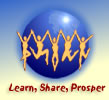Are You Aiming Your Sights at Your
Customers’ Downstream Success?
by Adele Sommers
Do you strive to ensure that your customers attain their highest goals and aspirations? And in doing that, are you consciously considering the success of your customers’ customers, or even of your customers’ customers’ customers? Without a plan for producing an extended chain of satisfaction, you’ll run the risk of developing products, services, or customized solutions that might fill your coffers but not provide any significant or lasting benefits to others.
The way we approach our projects can influence our customers’ success. Too often, we myopically limit ourselves to deliver only the “first-line” requirements. In so doing, we think primarily about what our customers or clients asked for, even if it’s not the most suitable fit for their own — or their customers’ — intended needs.
Although it’s commendable to listen to what our customers want, it’s also possible to generate an incomplete or incompatible result based on superficial information. For that reason, this article offers three ways to adjust our project vision from “20:20 hindsight” to “20:20 foresight” in this regard.
1. Consult Your Client’s or Customer’s “Crystal Ball”
 This method involves more types of questions than you might normally ask about the downstream benefits that your product, service, or solution will deliver. It entails querying your clients or customers about the results they expect to see from the product, service, system, training program, or whatever your project will produce for them. Here are examples: This method involves more types of questions than you might normally ask about the downstream benefits that your product, service, or solution will deliver. It entails querying your clients or customers about the results they expect to see from the product, service, system, training program, or whatever your project will produce for them. Here are examples:
- “Imagine the project results six months to a year after completion. What payoffs do you see for people in your organization? Describe the benefits in detail, as well as any limitations they might still be experiencing after everything is delivered.”
- “Now imagine how your customers or clients will benefit in the same period. What improvements in your products and services do you believe you will be able to pass along to them from this project? Will those improvements significantly enhance your clients’ or customers’ situations? If not, where are the gaps in the picture?” This question should help pin down the downstream outcomes that your client or customer can envision.
2. Use the “Persona Interview” Approach
 This method is especially useful if your project entails developing offerings for mass consumption — where there is no specific client or customer to please. It can also, however, work extremely well when you are working with a client, to help pinpoint specific kinds of concerns and options that would not have been readily apparent. This method is especially useful if your project entails developing offerings for mass consumption — where there is no specific client or customer to please. It can also, however, work extremely well when you are working with a client, to help pinpoint specific kinds of concerns and options that would not have been readily apparent.
With this technique, you begin by identifying a few imaginary characters known as “personas.” These characters represent typical consumers of the products, services, systems, Web sites, or courseware. Make your personas as realistic as possible by giving them names, ages, genders, professional or personal roles, friends, families, hobbies, educational backgrounds, and major challenges. Then, “talk” with them several times to see what you might learn.
These “interviews” often reveal new ideas and angles to consider. Once, I used this technique to “find out” how people might respond to a new information product I was planning to create. To my astonishment, one of my personas disclosed that she was taking advantage of the licensing program I had developed to allow others to teach the material. Up until that point, licensing had not even once crossed my mind — but you can be sure that I added it to my requirements list after that! This is a great example of how a downstream customer benefit can emerge in a persona interview.
Yes, these exercises do take some imagination. Once you start the process, however, you’ll be surprised at how much you can learn about the benefits — and any potential shortcomings — of a product, service, or made-to-order solution as defined by your initial assumptions.
3. Collect Input at Your Customer’s or Even Their Customers’ Sites
 In some situations, a customer or client may agree to have you interview people at their site, or possibly at one of their customers’ sites. This process can be considered part of an initial needs assessment, or research you conduct before upgrading your product or service. If you are providing an estimate for the project, you might even want to separate out this type of data-gathering into its own distinct phase. In some situations, a customer or client may agree to have you interview people at their site, or possibly at one of their customers’ sites. This process can be considered part of an initial needs assessment, or research you conduct before upgrading your product or service. If you are providing an estimate for the project, you might even want to separate out this type of data-gathering into its own distinct phase.
When the possibility of onsite interviewing presents itself, the purpose is to learn from as many different sources as possible how people perceive the situation that has led to the request for a solution or to your ideas for an upgrade.
Using the information gathered in this phase, you might acquire several insights that will reshape the initial set of requirements the client had requested. This could be the case if you and your client ultimately determine that the requirements do not seem to address the client’s — or the client’s customers’ — needs in the very best possible way.
And if you observe your customers while they are using your offerings at their own facilities, it may be a real eye-opener to watch them try to install, set up, learn, interact with, and troubleshoot your product without having someone guide them through every step. If you had intended your products to be self-explanatory and simple to use, this kind of field trip could reveal several aspects in which they are not!
In conclusion, by using a variety of techniques to expose more of your clients’ and customers’ needs, you can pinpoint more completely the project, product, or service requirements. And by consistently emphasizing the downstream “chain of successes” that your customers and their customers will enjoy, you’ll create perpetual value for all who use your offerings or your final project results.
Copyright 2021 Adele Sommers
|


